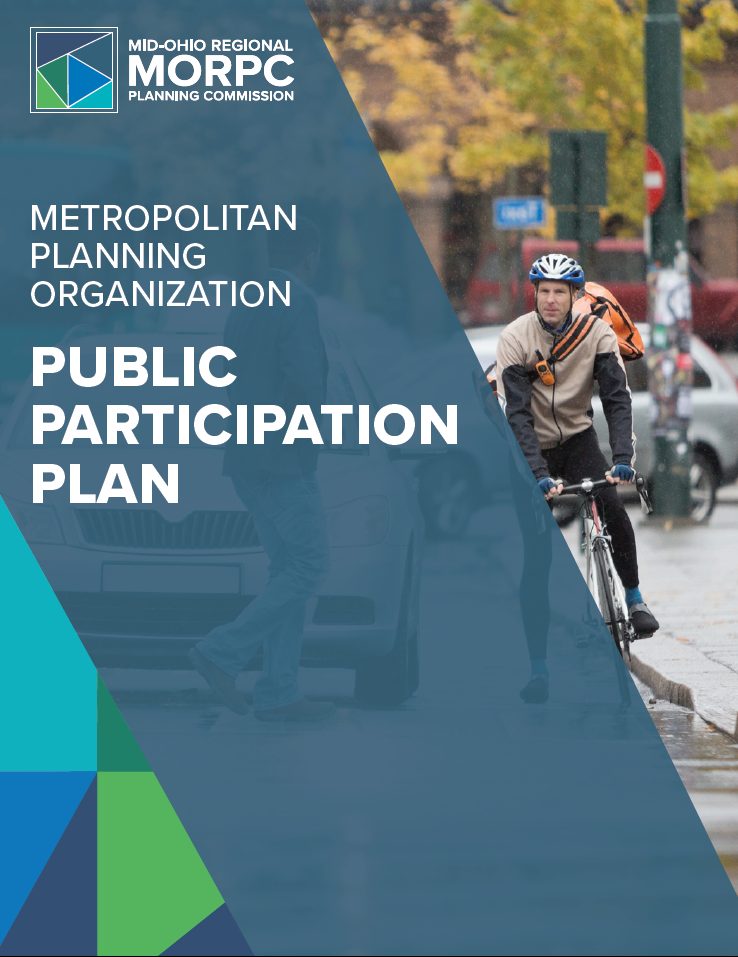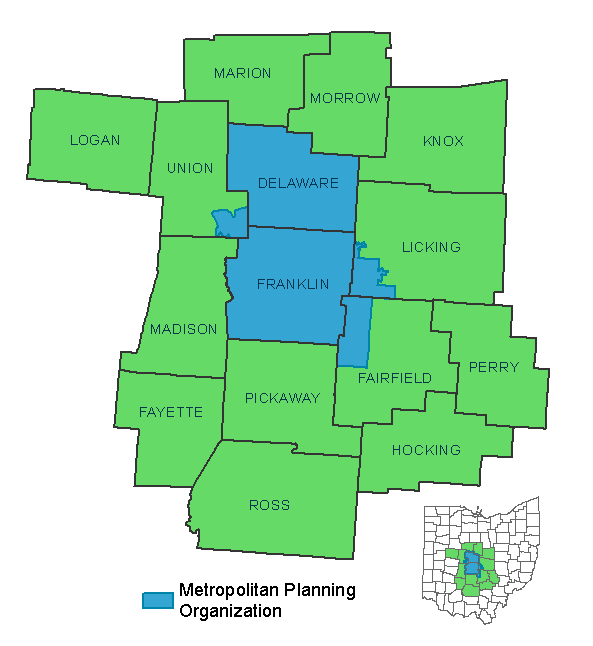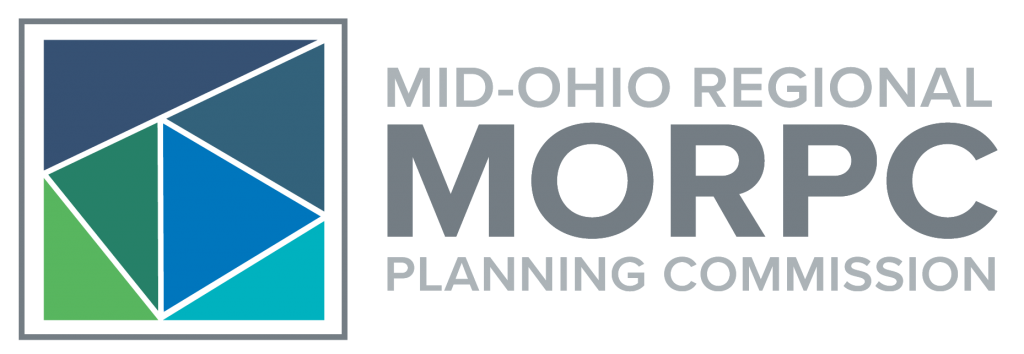
View the Public Participation Plan
The Public Participation Plan was recommended for approval by the Community Advisory Committee and Transportation Advisory Committee. It was adopted by the Transportation Policy Committee through Resolution T-10-21 on September 9, 2021.
Public Participation Plan
INTRODUCTION
The Public Participation Plan specifies the procedures that the Mid-Ohio Regional Planning Commission (MORPC) will use to reach members of the public for their input while conducting its transportation planning process. The plan also includes a section on environmental justice, the Americans with Disabilities Act, and nondiscrimination complaint procedures for programs and activities of MORPC.
BACKGROUND
The Mid-Ohio Regional Planning Commission (MORPC) is composed of local governments in Central Ohio. Franklin County and nearby counties, as well as their cities, villages and townships, are eligible for membership. Elected and appointed officials sit on the commission, which is the policy-making body of the organization.
The agency’s envisioned future for the 15 urban and rural counties it serves is one of prosperity and growth. The members and staff take pride in bringing communities of all sizes and interests together to collaborate and build consensus on economic and community development, transportation and other infrastructure projects, energy, and environmental sustainability.
Elected and appointed officials from local governments serve as representatives on the commission, which determines the strategic direction of the agency and sets its policies. All meetings are open to the public.
Because of MORPC’s role in the region, its Transportation Policy Committee was formed and designated by the U.S. Department of Transportation as the metropolitan planning organization (MPO) for the Columbus urbanized area in 1964. The Transportation Policy Committee maintains that role today.
 As of 2021, MORPC’s MPO area includes:
As of 2021, MORPC’s MPO area includes:
- Franklin County
- Delaware County
- Bloom and Violet townships in Fairfield County
- New Albany, Pataskala and Etna Township in Licking County
- Jerome Township in Union County
- The general public
- Minorities (Black or African Americans, Hispanic or Latinx, Asian or Asian Americans, American Indian or Alaska Natives, Native Hawaiian or Pacific Islanders)
- Foreign-born residents and foreign-speaking populations
- Those with disabilities
- Older adults
- Lower-income individuals and families
- Bicyclist
- Pedestrian facility users
- Public agencies
- Neighborhood/civic associations and area commissions
- Public transportation employees
- Intercity bus and rail operators
- Public transportation users
- Natural and built environment interests
- Business and employer interests
- Freight shippers and providers of freight transportation services
- Private providers of transportation
- Other interested parties
 The Public Participation Plan is reviewed periodically by the Ohio Department of Transportation, Federal Highway Administration, and Federal Transit Administration to ensure that full and open access is provided by the MPO, COTA, and DCT in the transportation decision-making process.
The plan outlined in the following sections enhances the opportunity for public input and satisfies federal requirements for public participation.
The Public Participation Plan is reviewed periodically by the Ohio Department of Transportation, Federal Highway Administration, and Federal Transit Administration to ensure that full and open access is provided by the MPO, COTA, and DCT in the transportation decision-making process.
The plan outlined in the following sections enhances the opportunity for public input and satisfies federal requirements for public participation. MORPC uses a three-tier process to solicit input in the development of transportation plans, programs, and policies. This process includes:
- A structured MPO committee process
- A study/project-specific process
- A public outreach / information collection and dissemination effort tailored to meet specific needs.
Tier 1: Metropolitan Planning Organization Committee Process
The MPO’s existing public involvement structure incorporates the activities of three transportation committees: the Transportation Policy Committee; the Transportation Advisory Committee (TAC); and the Community Advisory Committee (CAC).

The Transportation Policy Committee is the MPO, and therefore serves as the final decision-making body. The policy committee includes the representation of local elected officials, officials of agencies that administer or operate major modes or systems of transportation, appropriate state officials, and the chair of the Community Advisory Committee.
It is responsible for the review and adoption of all MPO planning work products such as the Public Participation Plan, the Planning Work Program, the long-range Metropolitan Transportation Plan, the four-year Transportation Improvement Program, major area studies or corridor plans, amendments to adopted plans and programs, COTA’s and Delaware County Transit’s programs and projects, and FTA funding such as the Section 5307 Urbanized Area Formula annual Program of Projects. The actions of the Transportation Policy Committee are based upon recommendations from the Transportation Advisory Committee and Community Advisory.
The policy committee meetings take place in tandem with MORPC’s full commission meetings, allowing many representatives from outside the MPO area to also be aware of MPO transportation-related decisions. For more information, see the Transportation Policy Committee Bylaws (Appendix A).
The Transportation Advisory Committee (TAC) provides technical advice, assistance, and recommendations to the Transportation Policy Committee and MPO staff. TAC review the procedures for and results of the various phases of the transportation planning process and special studies, methodology, projections, assumptions, and recommended plans, programs, strategies and solutions before submission to the Transportation Policy Committee.
TAC’s membership represents state, local, and federal transportation agencies, public utilities, public and private transportation providers, environmental and freight interests, and consultants. For more information, see the TAC Bylaws (Appendix B).
The Community Advisory Committee (CAC) provides recommendations to the Transportation Policy Committee from the perspective of residents, special interests, and communities. The CAC is one method by which the public can review and participate in all current transportation planning efforts, projects, and issues.
The CAC membership, as defined by its bylaws, is a broad representation of the community including, but not limited to, low-income and minority households, special interest groups, neighborhood and area commissions, and those traditionally underserved by transportation.
By having a membership that usually serves for several years, the CAC becomes educated about transportation issues, constraints, and processes and their relationship to other conditions in the community. For more information, see the and CAC Bylaws (Appendix C).
We strive to ensure that we are continuously improving diverse representation and voices on our committees and within our membership. Also, our goal is to commit to culturally competent committee members, which represent the diverse region that we serve.
All of these committees offer the chance for input to be provided on the MPO’s transportation work. The committees meet regularly throughout the year. In addition, MORPC’s MPO committee work is supplemented and informed by additional committees of MORPC, including the agency’s Sustainability Advisory Committee, Regional Data Advisory Committee, Regional Policy Roundtable, and the Central Ohio Rural Planning Organization.
All MORPC meetings are open to the public – in accordance with Ohio law – with advance notice and meeting materials posted at morpc.org. Although it is standard for these meetings to be held in person – and usually at the MORPC office – there may be virtual options for some people to participate.
Special assistance can be provided to individuals such as those who are hearing impaired, provided that arrangements are made reasonably in advance of the meetings.
MORPC keeps minutes of all regular committee meetings to keep track of public speakers and record comments, and to record the decision-making actions of the committees.
Tier 2: Study/Project-Specific Public Participation
Participation in specific studies occurs through the formation of committees or the utilization of standing committees, with these special studies having their own participation efforts as defined during the scoping of the study. Committee structure need is reviewed to ensure that the appropriate segments of the population and specific special interests are represented and encouraged to participate.
The committee members for these projects assist by addressing study issues through reviewing and providing feedback on information presented, answering questions at public meetings, and by providing information to their constituents. Study team members may supplement committee meeting presentations with presentations to committee member constituent groups.
Agencies that undertake area studies and corridor plans, where there is a specific need of intensive study to determine potential transportation needs and impacts, follow this process.
People who may be impacted directly by the study results are involved through the following process:
- Advisory groups may be established for the study, and standing committees that include representation of specific target groups may be formed. Representatives from appropriate neighborhood and area commissions, employers, resource agencies, businesses, special interests, and local, state and federal transportation agencies are invited to participate. The advisory group meetings are held in venues convenient to the study area and may include virtual options.
- Public meetings are scheduled in or near the study area at accessible locations, and they may also include virtual options. Invitations to attend the meetings are marketed through website postings, social media (including paid or boosted posts), electronic newsletters, and through direct and/or electronic mail to neighborhood and civic associations, employers, businesses, resource agencies, media, local communities, and other representative group in the study and transportation planning area.
Interim updates and final results of these studies or projects are presented to the advisory groups, Community Advisory Committee, Transportation Advisory Committee, Transportation Policy Committee, and other interested groups and communities. Short, written reports on progress may also be provided.
Information on the study milestones may be displayed in a newsletter and distributed to the media, general public, and public libraries, as well as placed on a website and on social media.
A webpage or website specifically for these studies or projects may be developed. If this is the case, all written documents and presentations will include the web address of the study.
MORPC’s website has the capability of being automatically translated into various languages. Draft and final versions are available for public review and comment on the website and with print materials available. Comments can be submitted written or orally.
Comments are to be summarized by the study team and included with the final plan/program documents. If a plan or program is changed significantly from the original format made available for public comment and raises new issues, additional opportunity for public comment on the revised document will be provided.
Tier 3: Public Outreach/Information Collection & Dissemination
MORPC engages the public in the transportation planning process through an array of outreach methods and options, including:
- Public meetings or focus groups (in person and/or virtual)
- One-on-one or small-group contacts
- Surveys
- Social media
- E-mail blasts
- Community events/festivals
- Presentations
- Website
- Interactive web maps and story maps
- Videos and podcasts
- Various printed marketing and collateral materials (often translated to additional languages)
- Public engagement digital platforms and applications
Upon request, MPO work products and documents are made available in alternative formats, if they can be reasonably accommodated by staff or consultants.
Public Outreach
The public outreach program for the Metropolitan Transportation Plan, the Transportation Improvement Program, COTA, DCT and FTA Section 5307 Program of Projects includes the following:
- Legal notices are placed, as required by 23 CFR 450.316, in local newspapers (with the largest circulation for each county and minority newspapers) at the beginning of work on a new Metropolitan Transportation Plan or Transportation Improvement Program.
- Legal notices are placed for public hearings.
- MORPC’s website is updated and press releases are distributed to the media announcing the availability of draft and final major reports, public review periods, public meetings, and other transportation planning efforts.
Posting of information on all transportation programs and projects can be found at morpc.org or on project-specific websites. MORPC’s website has the capability of being translated into various languages. Public comments can be submitted through the website, by electronic mail, or sent through U.S. mail.
Announcements to review draft reports and attend public meetings are sent to a list maintained by MORPC that includes neighborhood and civic associations, local communities, special interest groups, businesses, resource agencies, and other representative groups by direct and electronic mail. They are also placed on social media (including paid and boosted posts) and included in electronic newsletters.
MORPC’s periodic publications that provide information pertaining to various transportation activities include an electronic newsletter, the Regional eSource, and an annual printed report distributed to a mass audience – typically associated with the agency’s annual State of the Region event.
Copies of drafts and final reports for plans and programs are distributed to local libraries and are placed on the website.
Emergency Situations
In a period of a public health emergency or disaster recovery – when social distancing is required, or when a weather-related or other disaster prevents regular public involvement processes from going forward – alternative arrangements may be made to the participation process that continue to allow for meaningful involvement from members of the public. These may include alternative in-person meetings, virtual-only meetings, or other methods. MORPC will use the resources available to it to notify and inform the public of such changes.
The various components of the Metropolitan Transportation Plan are presented to the Community Advisory Committee, Transportation Advisory Committee, and Transportation Policy Committee for review and comment over the course of its development.
A notice of availability of the draft documents for review with a minimum 30-day comment period by the general public is distributed by social media (including paid and boosted posts), and by direct and electronic mail to neighborhood and civic associations, employers, resource agencies, media, and local communities. A web map with proposed projects is also available. A notice of availability and copies of draft documents are distributed to area libraries and placed on the website at morpc.org/mtp.
MTP Open House
The MPO hosts an open house at an accessible location at least 30 days prior to the adoption of the transportation plan. At the open house, a formal presentation that can be generally understood is provided, the various components of the transportation plan are displayed, and MPO staff is available to answer questions.
Invitations to attend the open house are posted on the website and social media (including paid and boosted posts), and distributed by direct and electronic mail to a list maintained by MORPC that includes: the Community Advisory Committee, Transportation Advisory Committee, Transportation Policy Committee members; neighborhood and civic associations; employers; resource agencies; social service agencies; media; local communities; and other representative groups in the transportation planning area.
The open house may include virtual components, and a copy of the formal presentation slides and/or video is placed on the website.
Comments on the MTP
Comments are received electronically, by U.S. mail, or submitted in writing at public meetings. MORPC will accommodate the needs of any member of the public in submitting comments within the allotted time period.
All comments received are considered public comments, and therefore are subject to disclosure under Ohio’s Public Records Act. All public comments received are reviewed for consideration and if found appropriate, are incorporated into the document. All responses are included in the final adopted document in a separate appendix. Copies of the final adopted document are sent to area libraries in the transportation planning area.
Amendments to the MTP
In order for transportation projects to be eligible for federal funding, they must be included in the Metropolitan Transportation Plan. At times, it may be necessary to amend the Metropolitan Transportation Plan – part of the continuous planning process. Amendments to the Metropolitan Transportation Plan will be made available to the public for a 30-day comment period prior to approval.
Amendments are brought before the Community Advisory Committee, Transportation Advisory Committee, and Transportation Policy Committee for approval after being included on the committee agendas and in the meeting materials in advance. The amendment and the revised Metropolitan Transportation Plan – including the revised project listing, map, and other amendment changes – will be placed on the website.
Upon request, MPO work products and documents are made available in alternative formats, if they can be reasonably accommodated by staff or consultants.
Prior to the development of the draft Transportation Improvement Program, a legal notice is placed in the major local and minority newspapers announcing the update. The notice will satisfy requirements for public participation in the development of the FTA Section 5307 Program of Projects.
A notice announcing the availability of the draft TIP for review, with a minimum 30-day comment period, is sent to neighborhood and civic associations, employers, resource agencies, media, and local communities. A web map with proposed projects is also available.
The notice distributed by direct and electronic mail and social media (including paid and boosted posts) announces the comment period and states where a copy of the document can be obtained or viewed. The draft document is distributed to area libraries in the planning area and placed on the website at www.morpc.org/tip.
TIP Open House
MORPC hosts an open house at an accessible location at least 30 days prior to the adoption of the TIP. Elements of the TIP, including the FTA Section 5307 Program of Projects, are displayed, and a presentation that can be generally understood is conducted on the information. MPO staff members are available to answer questions.
Invitations to attend the open house are posted on the website and social media (including paid and boosted posts), and distributed by electronic and direct mail to a list maintained by MORPC that includes: the Community Advisory Committee, Transportation Advisory Committee, Transportation Policy Committee members; neighborhood and civic associations; employers; resource agencies; social service agencies; media; local communities; and other representative groups in the transportation planning area.
The open house may include virtual components, and a copy of the formal presentation slides and/or video is placed on the website.
Comments on the TIP
Comments are received electronically, by U.S. mail, or submitted in writing at public meetings. MORPC will accommodate the needs of any member of the public in submitting comments within the allotted time period.
All public comments received are considered, and responses are included in the final adopted document located in a separate appendix. Copies of the final document are placed on the website and sent to area libraries in the transportation planning area.
Amendments to the TIP
Periodically amendments to the TIP are needed because the schedule, scope, or funding of a transportation project needs to be revised or a new project needs to be added to the TIP. This is part of the continuous planning process. Notice of the amendment will also satisfy the public participation requirements for the FTA Section 5307 annual Program of Projects.
The amendment is brought before the Community Advisory Committee, Transportation Advisory Committee, and Transportation Policy Committee for approval after being included on the committee agendas and in the meeting materials in advance. All amendments to the TIP are placed on the website. Significant amendments – those that simultaneously require a MTP amendment – are made available to the public for a 30-day comment period prior to approval.
Upon request, MPO work products and documents are made available in alternative formats, if they can be reasonably accommodated by staff or consultants.
ENVIRONMENTAL JUSTICE
Recognizing that federal policies, programs, rules and activities could have a disproportionate impact on protected groups, Executive Order 12898, “Federal Actions to Address Environmental Justice in Minority Populations and Low-Income Populations,” was issued in February 1994.
The needs of those traditionally underserved by the existing transportation system are sought and considered by the MPO. The following actions are meant to reduce the barriers faced by low-income and/or minority residents, older adults, or people with disabilities for participation in the decision-making process:
- Notices are mailed informing the underserved populations of opportunities to participate, major milestones, public meetings, and other avenues to participate and provide input.
- When possible, public meetings are held in locations that are located along a transit bus route, convenient to low-income populations, and accessible to people with disabilities. Such locations include public libraries, schools, community centers, and churches.
- Agencies and organizations that represent these populations are included in mailings, or contacted through e-mail, when possible.
Outreach to these groups is also part of MORPC’s broader diversity, inclusion, and equity efforts.
Upon request, MPO work products and documents are made available in alternative formats, if they can be reasonably accommodated by staff or consultants.
AMERICANS WITH DISABILITIES ACT
The Americans with Disabilities Act of 1990 (ADA) is a civil rights statute that prohibits discrimination against people with disabilities in all aspects of life. The ADA, therefore, calls for federally assisted programs to be accessible to people with disabilities.
People with disabilities are represented on MORPC’s Community Advisory Committee and encouraged to be involved in the transportation planning process, including the development and improvement of transportation and paratransit plans and services, through any of the various means described previously.
All public meetings conducted by the MPO take place at locations that have accessible facilities to accommodate people with mobility limitations.
NONDISCRIMINATION COMPLAINT PROCEDURES FOR PROGRAMS OR ACTIVITIES OF MORPC
MORPC does not discriminate on the basis of age, race, color, national origin, gender, sexual orientation, familial status, religion or disability in programs, services or in employment.
Information on non-discrimination and related MORPC policies and procedures is available at morpc.org. The information is also publicly displayed in the lobby and breakrooms of MORPC’s office.
Nondiscrimination procedures cover all external complaints regarding MORPC programs and activities filed under Title VI of the Civil Rights Act of 1964 or 49 CFR 21, “Nondiscrimination in the Federally Assisted Programs of the Department of Transportation.”
Information on how to file a complaint can be viewed on MORPC’s website at morpc.org/title-vi, where the agency’s Title VI Plan and Limited English Proficiency Plan are posted. Printed versions of the complaint process and the complaint form may be requested by calling or e-mailing MORPC’s Diversity, Inclusion and Engagement Officer at 614.233.4157 or rhampton@morpc.org.
MORPC staff is given the authority to make minor changes to wording and update hyperlinks within this Public Participation Plan to ensure the information is current and directed toward relevant and accurate supplementary sources.
Significant changes or amendments to the plan must be made available to the public for at least a 45-day comment period prior to approval. The updated plan or amendment is brought before the Community Advisory Committee, Transportation Advisory Committee, and Transportation Policy Committee for approval.
The most up-to-date version of the plan will be made available in a web-friendly format that includes a link to the printable PDF version. Printed copies are available upon request.
Refinement of Process
MORPC staff will periodically review the effectiveness of the procedures and strategies contained in the Public Participation Plan with regard to technology, people, and strategies in an effort to ensure a full and open participation process.

